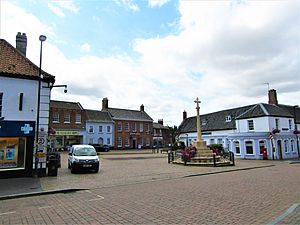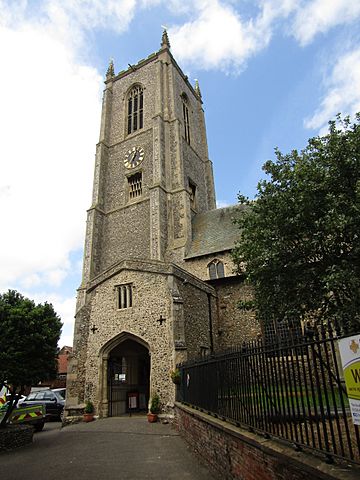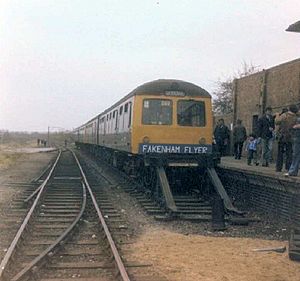Fakenham facts for kids
Quick facts for kids Fakenham |
|
|---|---|
 Market Place and war memorial |
|
| Area | 9.04 km2 (3.49 sq mi) |
| Population | 7,617 (2011 census) |
| • Density | 843/km2 (2,180/sq mi) |
| OS grid reference | TF918296 |
| District | |
| Shire county | |
| Region | |
| Country | England |
| Sovereign state | United Kingdom |
| Post town | FAKENHAM |
| Postcode district | NR21 |
| Dialling code | 01328 |
| Police | Norfolk |
| Fire | Norfolk |
| Ambulance | East of England |
| EU Parliament | East of England |
| UK Parliament |
|
Fakenham is a lively market town in Norfolk, England. It's located on the River Wensum, about 25 miles (40 km) north-west of Norwich. The town is a meeting point for several main roads. These include the A148, which goes from King's Lynn to Cromer, the A1067 to Norwich, and the A1065 to Swaffham.
Fakenham is also a civil parish, which is a local area with its own council. In 2011, about 7,617 people lived here in 3,292 homes. The town has been a market town since 1250. It was especially known for trading corn, barley, and wheat. Later, in the 1800s, it became famous for printing. Fakenham is also home to Fakenham Racecourse, where horse races take place.
The town has a longer official name: Fakenham Lancaster. This name comes from the year 1377. That's when the land was given to John of Gaunt, who was the Duke of Lancaster. This longer name is still used today. You can see it on history plaques around town. It also names the two local areas, called wards, that elect councillors to the North Norfolk District Council.
Contents
A Look Back: Fakenham's History
The name Fakenham comes from the Anglo-Saxons. It might mean "Facca's home" or "Fair Place." Many old arrowheads and flint tools have been found here. These show that people lived in Fakenham during the Stone Age. Two copper axeheads from the Bronze Age were also found. In 2015, a lead plaque was found near Fakenham. It dates back to the early Middle Ages. Some think it was used to help with illnesses, based on its runic writing.
Before 1066, King Harold owned Fakenham. After the Norman Conquest, William the Conqueror took it over. Fakenham was a large area, including nearby villages like Pudding Norton. Old brooches, buckles, and pottery from the Saxon period have been found. A Middle Saxon coin from King Beonna was also discovered. The Domesday Book of 1086 mentions a watermill in Fakenham.
In 1297, Guy Ferre became the owner of Fakenham Manor. King Edward I had given it to him for life. Over the centuries, some small villages near Fakenham became less populated. For example, Thorpland had many people in the 1200s, but today only a hall remains.
Fakenham has faced several fires over the years. Fires in 1660, 1718, and 1738 destroyed many buildings. The fire on August 4, 1738, burned down 26 buildings in the town.
Where is Fakenham?
Fakenham is located in the North Norfolk area. It sits between Pudding Norton and Barsham. The town is on the north side of the River Wensum. It is about 19 miles (31 km) north-east of King's Lynn. It's also 19 miles (31 km) south-west of Cromer and 25 miles (40 km) north-west of Norwich.
South-east of Fakenham is Pensthorpe Natural Park. This park has over 700 acres of woods and lakes. It also features four beautiful gardens to explore.
How Fakenham Makes a Living
Fakenham has been a market town since 1250. Farmers have long sold their crops and animals at the town's markets. People from nearby ports would come to buy corn. The main market day is Thursday. A lot of barley and wheat are still sold there.
In the 1800s, Fakenham became a big center for printing. This continued into the 1900s. Today, Fakenham Prepress Solutions is a modern printing company in the town. The Kinnerton Confectionery Company, which makes sweets, also started in Fakenham in 1978.
Cool Places to See in Fakenham
Fakenham has the beautiful 14th-century Saint Peter and Saint Paul Parish Church. It was built where an older Saxon church once stood. The church's tall tower, which is 115 feet (35 meters) high, was added in the 15th century.
Baron's Hall was first built in 1593. However, it was torn down in 1812. A new hall opened in 1825. The Corn Exchange opened in 1855. It replaced an older building where court sessions were held. During World War II, the Corn Exchange was the local base for the Home Guard.
Some buildings in Fakenham still have parts from the 1600s. These include The Star Inn on Oak Street, Grove House, The Red Lion, The Wooden Horse, and Barclays Bank. The town also has the Fakenham Museum of Gas and Local History. Here, you can see old equipment used to make gas from coal.
Sports and Fun in Fakenham
Fakenham has a long history with sports. Fakenham Cricket Club is one of the oldest in Norfolk. It started in 1815 as a combined team. In 1883, it became its own club. The club's first team has won several league titles, including in 2001, 2011, 2015, and 2018. Queens Road Recreation Ground is a public park in the middle of Fakenham.
Fakenham Golf Club is located on the southern edge of town. It was first set up in 1889. The current golf course, which is 6,245 yards long, was designed in 1974.
Fakenham Racecourse is a famous place for thoroughbred horse racing. It's located south of the town. Charles III is a supporter of the racecourse. It also hosts the West Norfolk Hunt's Point to Point steeplechase, which is a type of horse race over fences.
Getting Around Fakenham
Trains in Fakenham
Fakenham no longer has its own train stations for regular passenger services. The closest train stations are in Norwich, King's Lynn, and Sheringham.
The town used to have two train stations:
- Fakenham East opened in 1849. It was the end of the line for the Wymondham to Wells Branch railway. The line was later extended to Wells-next-the-Sea in 1857. The station was renamed Fakenham East in 1948. It closed to passengers in 1964.
- Fakenham West opened in 1880. It was part of a main railway line that went across Norfolk. This line connected King's Lynn to Sheringham, Cromer, Norwich, and Great Yarmouth. Fakenham West station closed in 1959.
The two railway lines never connected directly. The line from Fakenham West crossed over the line from Fakenham East on a bridge. Even after Fakenham East closed to passengers, the line stayed open for goods. A special passenger train called the Fakenham Flyer ran on April 21, 1979. But this was the only time, as the line closed completely the next year.
Buses and Roads
Fakenham is served by several bus routes. Different companies run these buses. You can take buses towards Holt and Sheringham with Sanders Coaches. Lynx buses go to Wells-next-the-Sea and King's Lynn. First Norfolk & Suffolk buses travel to Norwich. Konectbus also offers routes to Dereham.
The town is a junction for several important roads. These include the A148, which connects King's Lynn to Cromer. The A1067 goes to Norwich, and the A1065 leads to Swaffham. A bypass road was built in the mid-1980s. This road carries the A148 around the north side of the town, helping to reduce traffic in the center.
Famous People from Fakenham
Many interesting people have come from Fakenham:
- Thomas Miller was a bookseller and someone who studied old things.
- Sir Robert Seppings was a skilled shipwright (someone who builds ships). He was knighted in 1819.
- Sir George Edwards was a leader for farm workers. He later became a local MP.
- Peter Parfitt was an England and Middlesex cricketer in the early 1960s. He went to Fakenham Grammar School.
- Horatio Nelson was a famous British naval officer.
- Simon Dring was a journalist and television producer.
Other notable people include football-playing brothers Ryan Jarvis and Rossi Jarvis. They both played for Norwich City. Adam Tann, their cousin, also played professional football. Another former Norwich City footballer, Matt Gill, grew up in Fakenham and went to the local schools.
See also
 In Spanish: Fakenham para niños
In Spanish: Fakenham para niños




